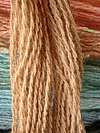Maclura tinctoria
| Maclura tinctoria | |
|---|---|
 | |
| Scientific classification | |
| Kingdom: | Plantae |
| (unranked): | Angiosperms |
| (unranked): | Eudicots |
| (unranked): | Rosids |
| Order: | Rosales |
| Family: | Moraceae |
| Tribe: | Moreae |
| Genus: | Maclura |
| Species: | M. tinctoria |
| Binomial name | |
| Maclura tinctoria | |
| Synonyms[1] | |
| |
Maclura tinctoria, commonly known as old fustic or dyer's mulberry[2] is a medium to large tree of the Neotropics, from Mexico to Argentina. It produces a yellow dye called fustic primarily known for coloring khaki fabric for U.S. military apparel during World War I. This dye contains the flavonoid morin.[3]
The leaves can be used to feed silk worms.[4]
Old fustic is not to be confused with young fustic (Rhus cotinus) from southern Europe and Asia, which provides a more fugitive colour.
Dyeing
Fustic is a bright yellow dye that is very color-fast when used with mordants. It is frequently combined with other dyestuffs and various mordants to produce a range of yellow and greenish colors:[2]
- With woad or indigo: bright or Saxon greens
- With bichromate of potash: old gold
- With logwood and bichromate of potash: greenish yellows
- With copper sulfate: olive greens
- With ferrous sulfate: dark greens
References
- ↑ "Maclura tinctoria". Germplasm Resources Information Network (GRIN). Agricultural Research Service (ARS), United States Department of Agriculture (USDA). Retrieved 17 December 2017.
- 1 2 Goodwin, Jill (1982). A Dyer's Manual. London: Pelham Books Ltd. p. 60. ISBN 0-7207-1327-7.
- ↑ "Morus tinctoria". Retrieved 20 February 2010.
- ↑ Mabberley, D.J. (1997). The plant book: A portable dictionary of the vascular plants. Cambridge: Cambridge University Press.
| Wikimedia Commons has media related to Maclura tinctoria. |
| Wikispecies has information related to Maclura tinctoria |
This article is issued from
Wikipedia.
The text is licensed under Creative Commons - Attribution - Sharealike.
Additional terms may apply for the media files.
